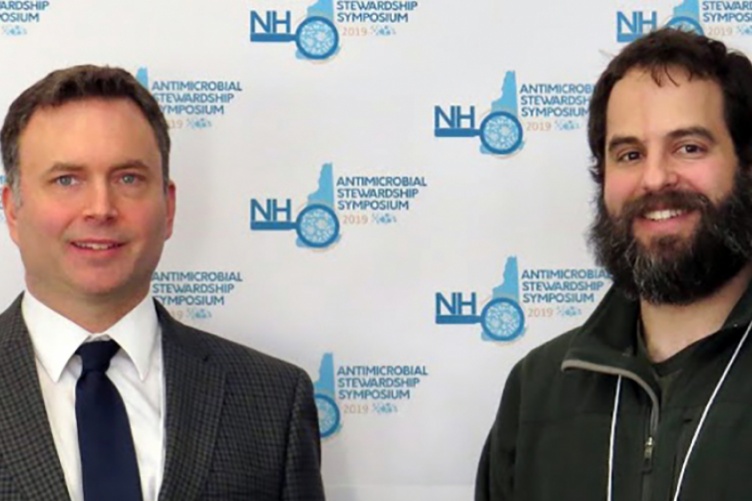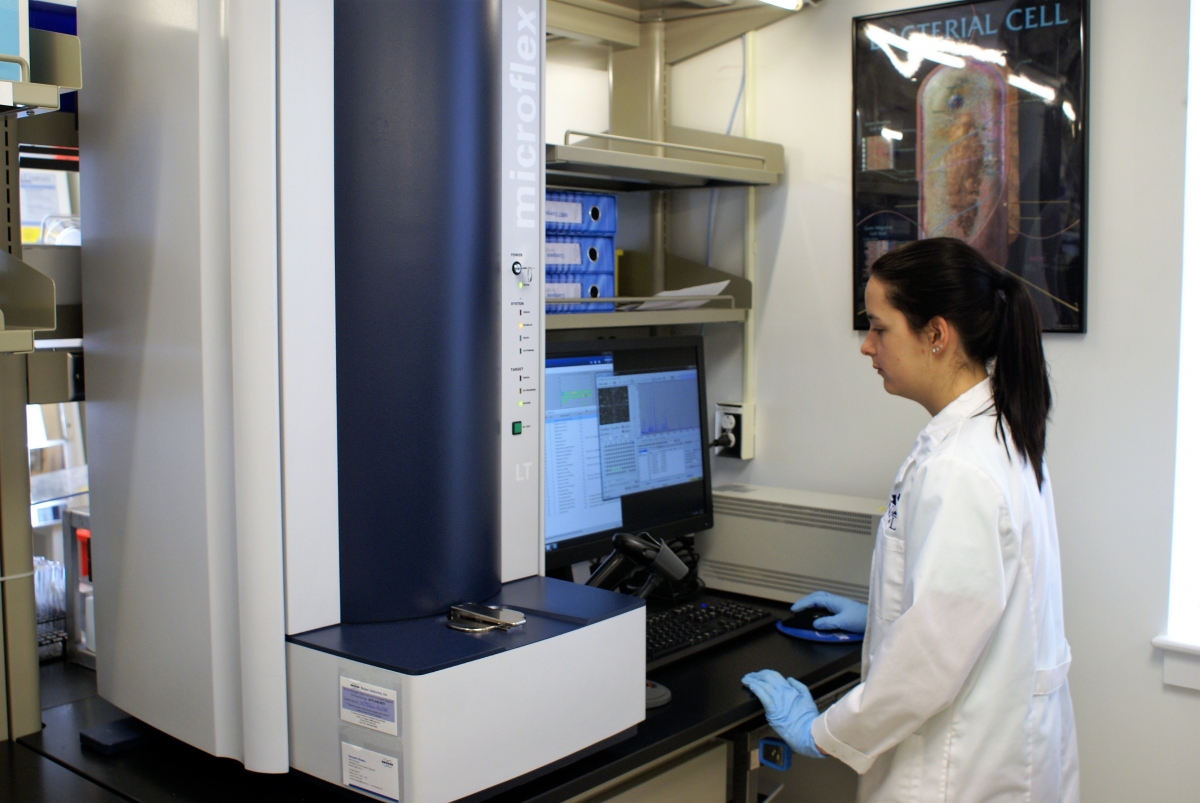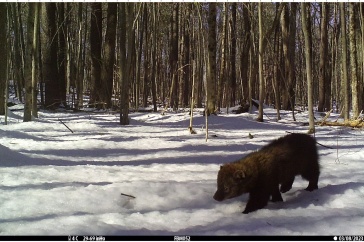

at the NH Veterinary Diagnostic Lab at UNH. Credit: Rob Gibson/UNH
The New Hampshire Veterinary Diagnostic Laboratory recently was recognized by the state for its efforts to mitigate antimicrobial resistance by rapidly identify infections in
animals and performing other diagnostic tests in service to the state and region.
The laboratory received the New Hampshire Antimicrobial Stewardship Award from the New Hampshire Division of Public Health Services. Antibiotic resistance occurs when bacteria change in some way that reduces or eliminates the effectiveness of drugs, chemicals, or other agents designed to cure or prevent infections. The bacteria survive and continue to multiply, causing more harm.
As part of the NH Agricultural Experiment Station at the University of New Hampshire, the New Hampshire Veterinary Diagnostic Laboratory serves the state of New Hampshire as a key partner with the New Hampshire Commissioner of Agriculture and State Veterinarian in their efforts to monitor and control important animal diseases. The lab also provides diagnostic services to hundreds of veterinarians from New Hampshire and New England who use the lab’s histopathology, microbiology, serology, and necropsy services for the diagnosis of animal diseases in pets, farm animals, wildlife, zoo, and marine animals.
“As veterinarians, we are obligated to help protect public health. We do this in the name of One Health. One of the current issues of greatest concern and interest to One Health is the mitigation of antibiotic resistance. This is a wildly complex issue, and the engagement of both animal and public health experts is critical. One of the best ways to improve antibiotic stewardship is with rapid and accurate diagnostic testing and recommendations,” said Stephen Crawford, New Hampshire State Veterinarian.
“The New Hampshire Veterinary Diagnostic Laboratory is leading this charge in the Northeast with the addition of new technologies that improve both speed and accuracy in diagnosing infections and identifying the correct antibiotics to treat them. This can be done in as little as one day with the MALDI-TOF at the New Hampshire Veterinary Diagnostic Laboratory,” Crawford said.
When the state experiences an outbreak of an infectious disease in animals, the time it takes to identify the disease can have a significant impact on the treatment and outbreak response. With support from the New Hampshire Agricultural Experiment Station, in 2017 the New Hampshire Veterinary Diagnostic Laboratory sharply reduced from what could take days, down to minutes after acquiring Matrix Assisted Laser Desorption Ionization Time of Flight Mass Spectrometry (MALDI-TOF) instrumentation, a sophisticated type of mass spectrometry.

The MALDI-TOF breaks complex molecules into smaller pieces, which are separated by atomic mass, producing a “molecular fingerprint” to quickly identify infectious agents. The fingerprint is matched against a database of known infectious agents. Mass spectrometry, while not a new technology, is new in the application of clinical microbiology and is revolutionizing microbiology labs worldwide.
“MALDI-TOF provides rapid and accurate identification of microbial agents. With thousands of organisms in the database, this is the most in-depth level of identification available other than performing DNA sequencing, which can be more costly and time consuming. After the organisms are grown, the time for a bacterial identification is minutes when compared to the traditional methods, which can take days,” said Robert Gibson, managing director of the New Hampshire Veterinary Diagnostic Laboratory.
“Accurately and rapidly identifying infectious agents is critical in safeguarding animal health, public health and New Hampshire agriculture. The majority of infectious diseases in people, including the top bioterrorism agents, are considered zoonotic, which means they can be transferred from animals to humans. The speed at which we will be able to help diagnose contagious and reportable diseases to our clients and regulatory officials will have a significant impact on treatments and outbreak response,” Gibson said.
Crawford explained that even with a quick diagnosis, it is often important to begin antibiotic treatment before a confirmed diagnosis is returned. This creates opportunity for incorrect antibiotic choices that may need to be changed within a day or two, which is unhelpful for managing resistance. The New Hampshire Veterinary Diagnostic Laboratory’s work toward developing a veterinary antibiogram – a tool that compares common infections in the state with the most effective medications to treat those local bacteria – from its sample library will reduce this risk by providing veterinarians with an educated start to begin antibiotic treatment while they await test results.
“It is a commonly held belief by the general public that food animals are the greatest source of antibiotic resistance in veterinary medicine. The New Hampshire Veterinary Diagnostic Laboratory has accumulated an abundance of data that may shed new light on this opinion. Based on its work related to antibiotic resistance over many years, the lab’s data indicate that within its population of patients, companion animals like dogs and cats are more likely than food animals to be harboring antibiotic-resistant bacteria,” Crawford said.
The lab serves the state of New Hampshire by providing accessible, timely, and accurate diagnostic services for the New Hampshire Department of Agriculture, Markets, & Food, New Hampshire Department of Health and Human Services, New Hampshire Fish and Game Department, state and local law enforcement agencies, veterinarians, farmers, and other relevant state, regional, and federal agencies. It is co-funded and co-managed by the New Hampshire Department of Agriculture, Markets & Food and the UNH College of Life Sciences and Agriculture. It has served the state and the university since 1970, working at the junction of animal health, public health, environmental health, and economic health.
Founded in 1887, the NH Agricultural Experiment Station at the UNH College of Life Sciences and Agriculture is UNH’s original research center and an elemental component of New Hampshire's land-grant university heritage and mission. We steward federal and state funding, including support from the USDA National Institute of Food and Agriculture, to provide unbiased and objective research concerning diverse aspects of sustainable agriculture and foods, aquaculture, forest management, and related wildlife, natural resources and rural community topics. We maintain the Woodman and Kingman agronomy and horticultural research farms, the Macfarlane Research Greenhouses, the Fairchild Dairy Teaching and Research Center, and the Organic Dairy Research Farm. Additional properties also provide forage, forests and woodlands in direct support to research, teaching, and outreach.
-
Written By:
Lori Wright, '06G | NH Agricultural Experiment Station | lori.wright@unh.edu | 16038621452

















































